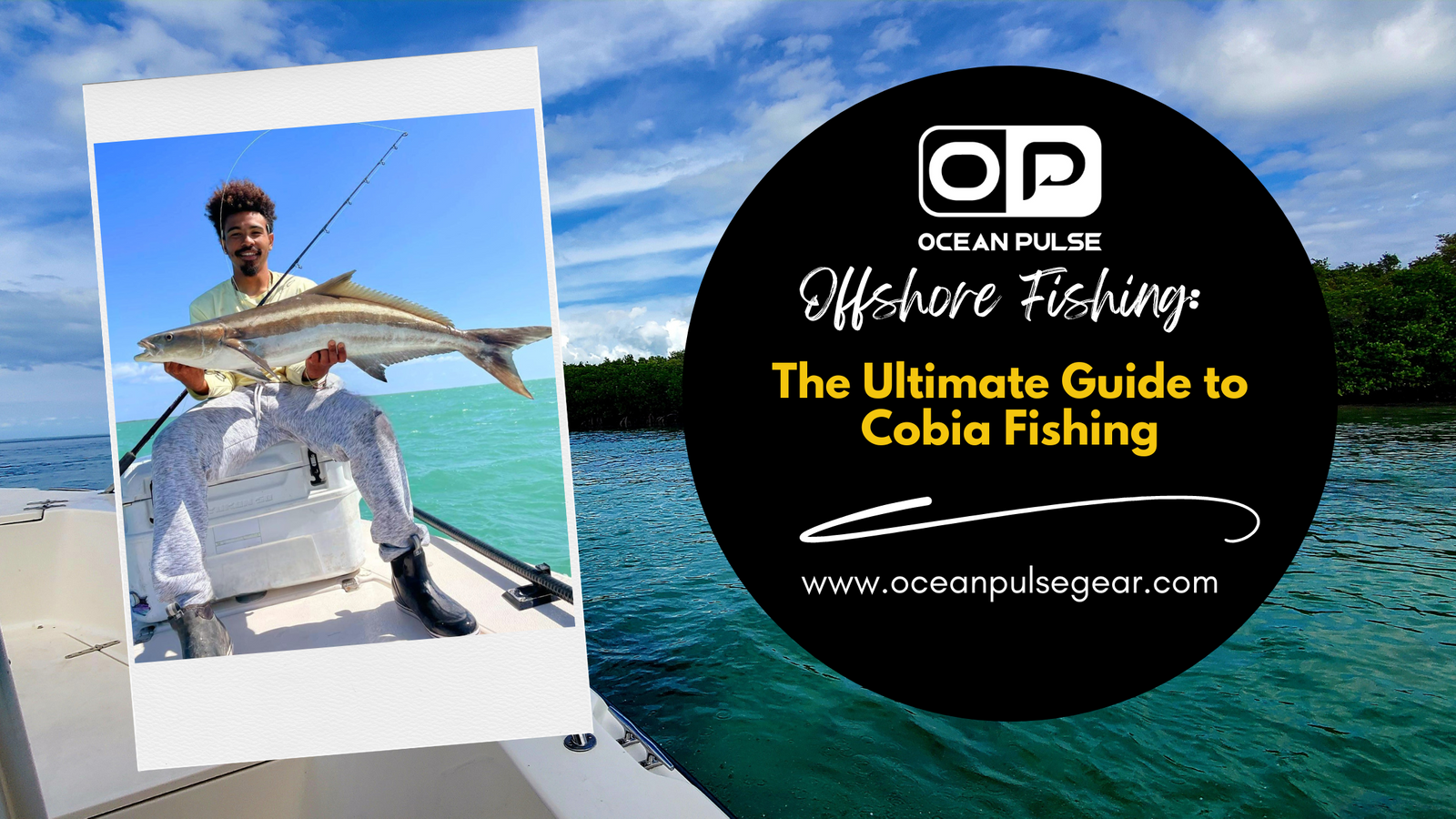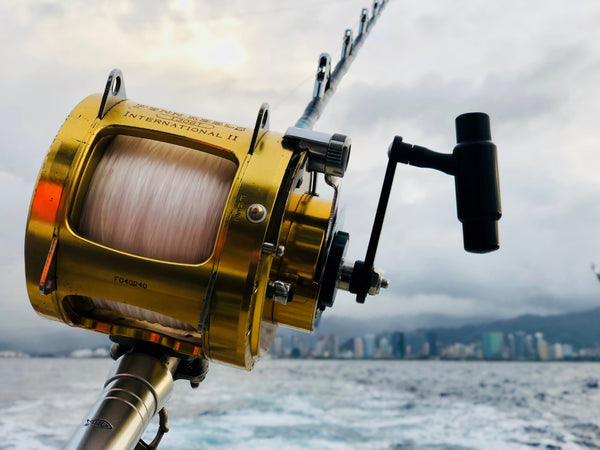Welcome to Ocean Pulse Gear, Please Enjoy Free Shipping on all orders!
Welcome to Ocean Pulse Gear, Please Enjoy Free Shipping on all orders!
The Ultimate Guide to Cobia Fishing
October 15, 2025 4 min read

Introduction to Cobia
If there’s one fish that perfectly blends power, flavor, and excitement, it’s the mighty Cobia. These sleek, bronze-backed bruisers are known for their bulldog runs, stubborn headshakes, and habit of cruising just below the surface, daring anglers to spot and tempt them. Whether you’re sight-casting off a tower or chumming off a wreck, few species deliver the same rush when that dark shadow turns and crushes your bait.
Once hooked, Cobia fight with sheer determination and brute strength, making them one of the most rewarding catches in warm coastal waters. When it comes to table fare, you’ll be planning a second trip before you even finish grilling the first fillet.

@saltlife_migzz with an awesome cobia
Species: Rachycentron canadum
Description: Long, torpedo-shaped body with a dark brown to black upper side fading to a white belly. Flat head, pronounced lower jaw, and a dorsal fin lined with short, sharp spines.
Size Range: 20–40 inches (average), up to 78 inches (maximum)
Weight Range: 10–50 pounds (average), up to 135 pounds (maximum)
Life Span: Up to 15 years
Habitat and Behavior
Cobia are highly migratory, roaming warm coastal waters in search of structure and food. They’re often found shadowing rays, turtles, and buoys, picking off easy meals along the way. These predators love variety: crabs, baitfish, squid, and shrimp are all on the menu.
-
Typical Habitat: Coastal waters, reefs, wrecks, buoys, navigation markers, and offshore rigs
-
Depth Range: Surface to 100 feet
-
Feeding Style: Carnivorous ambush predator and opportunistic feeder
-
Seasonal Patterns: Peak activity in spring and fall migrations; they remain nearshore in warmer months and move deeper when temperatures drop
Gear and Tackle Recommendations
Battling a Cobia requires tackle that can handle long, drag-screaming runs and sudden dives toward structure.
-
Rod and Reel: Medium-heavy to heavy spinning or conventional setup, 7- to 8-foot rod with strong backbone
-
Line Type and Strength: 30–50 lb braid for power and sensitivity, or 25–40 lb mono for stretch
-
Leader: 40–60 lb fluorocarbon to handle abrasive jaws and reduce visibility
-
Hook Size: 4/0–8/0 circle or J-hooks depending on bait size
-
Weights: 1–4 oz egg sinkers or bank weights; adjust based on current and depth
-
Pro Tip: Keep your drag smooth but firm. Set it at about one-third of your line’s test strength to prevent snap-offs during the initial run.
Bait Selection
When it comes to Cobia, the fresher the bait, the better the bite.
-
Live Baits: Eels, pinfish, crabs, and large shrimp are irresistible
-
Cut Baits: Mullet chunks, squid, or ladyfish strips
-
Artificial Lures: Large bucktail jigs (2–4 oz), soft plastics on heavy jig heads, deep-diving plugs, and metal spoons
-
Presentation Tips: Present your bait naturally. Cobia often inspect before striking, so keep live baits lively and work jigs with slow, deliberate hops
-
Bait Freshness: Always use the freshest bait possible. Dull or soggy baits rarely get the nod
Fishing Rigs
Choosing the right rig setup can make all the difference between “hooked up” and “see ya later.”
-
Fish-Finder Rig: Sliding sinker above a swivel, followed by 3–4 feet of 40–60 lb fluorocarbon leader and a 5/0–8/0 hook. Ideal for presenting live bait near bottom structure
-
Knocker Rig: Egg sinker sits directly above the hook. Great for fishing tight to the bottom with less leader tangling
-
Sliding Sinker Rig: Simple and effective for drift fishing; the mainline runs through a sinker, then to a swivel and short leader
Effective Fishing Techniques
Sight Fishing
Few moments in fishing beat spotting a Cobia cruising on the surface.
Steps:
-
Scan the area around buoys, wrecks, or rays for dark shadows
-
Cast a live crab, eel, or large jig ahead of the fish’s path
-
Retrieve slowly and naturally; Cobia are curious but cautious
-
Once it strikes, let it eat, then drive the hook home and hang on
Chumming
Draw Cobia to your boat with a strong scent trail.
Steps:
-
Anchor or drift near structure
-
Deploy chum made from oily fish such as menhaden or mackerel
-
Use live or cut bait on a fish-finder rig in the slick
-
Stay alert; Cobia often appear suddenly behind the boat
Trolling
Great for covering ground when fish are scattered.
Steps:
-
Troll deep-diving plugs, spoons, or rigged ballyhoo near structure or bait schools
-
Maintain 3–5 knots and adjust speed with conditions
-
Use downriggers or planers to keep lures in the strike zone
Tips for Consistent Success
-
Positioning: Target structure edges, wrecks, and temperature breaks
-
Anchoring: When chumming, anchor uptide so the slick drifts over structure
-
Hook-Set: Cobia often mouth the bait first; wait for steady pressure before setting the hook
-
Adaptability: Be ready to switch from live bait to jigs when fish are finicky
Best Time of Year to Catch Cobia
Cobia fishing peaks in spring and fall during migration periods, especially along the Gulf Coast, East Coast, and Florida Panhandle. In warm regions such as South Florida, they can be targeted year-round, though activity drops slightly in mid-summer heat.
Conservation and Regulations
Help keep Cobia populations strong by fishing responsibly.
-
Size and Bag Limits: Check current state and federal regulations, as they vary by region
-
Ethical Practices: Use circle hooks, handle fish gently, and release undersized or excess catches
-
Sustainability Tip: Support local conservation programs and report tagged fish to aid research
Local Knowledge and Expert Advice
South Florida captains often joke that Cobia are the “bonus fish” since they show up when you least expect them. Keep a dedicated pitch rod ready with a live crab or jig anytime you’re near a wreck, buoy, or ray. Many anglers lose fish by horsing them too soon, so take your time and wear them down.
Common Mistake: Don’t rush the gaff shot. Cobia are notorious for one last thrash right at the boat.
Conclusion
Cobia fishing delivers everything a saltwater angler could ask for: adventure, challenge, and top-tier table fare. With the right gear, tactics, and a bit of patience, you’ll be ready to tangle with one of the ocean’s hardest-fighting and most delicious fish.
Leave a comment
Comments will be approved before showing up.

Become an OP VIP, sign up for exclusive discounts offers and event coverage.
Sign up below!
